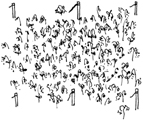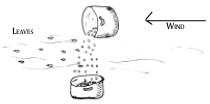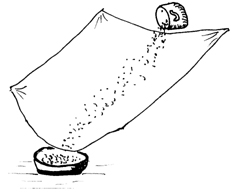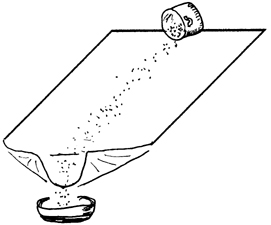Alaska Science Camps, Fairs & Experiments
ANKN is a resource for compiling and exchanging information
related to Alaska Native knowledge systems and ways of knowing. We
are pleased to create and distribute a variety of publications
that assist Native people, government agencies,
educators and the general public in gaining access to the knowledge
base that Alaska Natives have acquired through cumulative experience
over millennia.
TO ORDER THIS PUBLICATION:
Contact the ANKN
offices at 907-474-1902 or email uaf-cxcs@alaska.edu.  Berry
Pickers Berry
Pickers
 During
the fall of every year, most Alaskans are very busy. One of the most
important activities is picking berries to store for winter. For many
decades steel berry pickers have been available. During
the fall of every year, most Alaskans are very busy. One of the most
important activities is picking berries to store for winter. For many
decades steel berry pickers have been available.
They have several advantages:
- They pick berries very fast.
- They hold a quite a few berries before needing to be dumped
into a bucket or other container.
They have disadvantages:
- They also pick leaves, sticks, and other undesirable material,
making the berries dirty.
- There is also a controversy. Some people say the berry pickers
damage the blueberry bushes. Other people say they do less damage
than bears, and are therefore not harmful. No one says they harm
lowbush cranberry bushes.
One village will allow anyone to come and pick blueberries in
their area, but won't allow anyone to use steel berrypickers.
It will take time, careful observation, and measuring to do the
following experiment, but a good scientific answer is possible.
 Find
several patches of blueberries. With flagging, divide the blueberry
patches roughly in half. Harvest the berries on one side by hand, and
the other side with a berry picker. There are three ways to measure
the harvest from each section: by weight, by volume, or counting each
berry. I would probably go by weight. Find
several patches of blueberries. With flagging, divide the blueberry
patches roughly in half. Harvest the berries on one side by hand, and
the other side with a berry picker. There are three ways to measure
the harvest from each section: by weight, by volume, or counting each
berry. I would probably go by weight.
Record the weight, volume or number of berries from each
section.
Examples: Handpicked area =1356 grams of berries. Picker area =
834 grams. The berries from the handpicked area represents 62% of the
berries in the patch. Another area has 378 handpicked berries while
the picker area has 276. The berries from the handpicked area thus
represent 58% of the berries.
To be accurate, mark and harvest several patches in this same
manner recording all data.
Considerations
There are many variables involved in a blueberry harvest:
- Amount of rain, sunshine, spring snow melt
- Timing of rain and sunshine
- First frost, etc.
Do the same measurement for two more years in exactly the same
spot. Does the percentage of berries decrease in the area harvested
with the berry picker?
The number of berries in one year might vary greatly from one year
to another, so compare the percentage of berries picked in the two
sections, metal picker and hand picked. The question you are trying
to answer is: Does a berry picker help or harm the berry production?
Does the percentage of berries from the area harvested with the steel
picker go up, down, or stay the same from year to year?
 You
might want to put a sign over your berry patches asking people to
leave the berries alone because you are doing a scientific experiment
there. You
might want to put a sign over your berry patches asking people to
leave the berries alone because you are doing a scientific experiment
there.
Some scientific experiments take many years. A bear or birds
harvesting in your patch one year might throw the conclusion off.
You will have to pick the berries at the same time each year. When
berries are overripe, the berry picker smashes berries, and the count
will be off if you are measuring by volume.
This is an important experiment that needs to be done. We want to
care for our berry patches, and we don't want unnecessary conflict
between people. This experiment will take the discussion from the
realm of opinion into the realm of fact.
Cleaning Berries
After the berries are picked, they must be cleaned. Some people
pick berries very clean and some (like me) pick like a brown bear
(lots of rubble).
There are several ways of cleaning berries.
Our oldest daughter goes over every berry on the table, plucking
the stems from each berry. That's too tedious for most
people.

Oldtimers used to pour the berries from one container to another
in a strong wind. The leaves and sticks have more surface area and
less weight than the berries, and therefore blow away. The berries
are heavier and drop into the bottom container. The only problem is
the lack of a strong wind at the critical time of cleaning. If
berries sit too long, some of them smash and the wet leaves stick to
the good berries. They must be cleaned by wind soon after
picking.
My wife and I had another way. I drove the boat and she poured the
berries. We created our own wind. We didn't have electricity for a
fan in those days.

LEAVES STAY BEHIND
Oldtimers also cleaned berries by pouring the berries down
a
blanket. The berries roll, and the leaves don't. They are classified
by shape.

PLYWOOD UNDER BLANKET
Round rolls and flat doesn't. This works well, but the pitch of
the blanket often varies. If it is too steep, the leaves tumble into
the bucket too.
We put a piece of plywood under the blanket, funneling only the
bottom to channel the berries into the bucket.
Try different methods of separating berries from the leaves and
sticks by using wind. A variable-speed fan provides many
opportunities to experiment. You will note that berries that fall a
long ways will damage when they hit, especially those picked later in
the year.
Try rolling berries down a blanket. Try different pitches of the
blanket. Put a piece of plywood under the blanket. Does this help
control the angle of the incline? Does the type of blanket make any
difference (wool, cotton, nylon, etc.)?
What percentage of berries must be green to get the same gelling
effect as the commercial pectin? 5%, 10%, 25%, etc.
Does it help to smash the green berries, making the pectin more
readily available to the jam?
While commercial pectin is relatively inexpensive, the
time might come when it won't be available, and we need to know the answers
to
these questions.
 Jam Jam
We now use commercial pectin to make jams and jellies. However,
green berries contain pectin that can take the place of the
commercial product.
Of course, there are more green berries available in the beginning
of the season than there are at the end of the season.
|